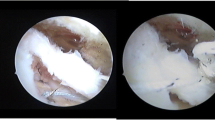Abstract
Purpose
The current study was designed to evaluate the rate of osteolysis and the clinical and functional outcomes in patients who underwent mini-open rotator cuff repairs using first generation bioabsorbable suture anchors. Our hypothesis was that patients with osteolysis noted on post-repair MRI would have an accompanying decrease in functional and clinical patient outcomes when compared with patients who did not have osteolysis evident on post-repair MRI.
Type of study
Clinical retrospective study.
Methods
Between September 2000 and May 2004, 76 patients were repaired using first generation Bio-Corkscrew suture anchors (Arthrex, Naples, FL). 30 patients were available for complete follow-up evaluation. The mean follow-up time was 36 months (range 24–58). Patients were assessed with the Constant–Murley Score, radiographs and magnetic resonance imaging (MRI). Post-operative strength was measured using an Isokinetic Cybex-Dynamometer. 14 patients had osteolysis evident on MRI (Group A) while 16 patients did not have osteolysis on MRI (Group B).
Results
In both groups, a total of 70 bio-anchors were used. 22 anchors showed osteolytic changes on MRI (Group A). Concerning ROM, there was no statistical difference in both groups. The Constant-Score was statistically not different in both groups A (92.4) and B (83.7). On MRI-scans, there were repair failures in both groups (A, 2 reruptures; B, 3 reruptures).
Conclusions
Although, we found a high rate of osteolysis after rotator cuff repair with bioabsorbable anchors, these results did not change the clinical outcomes after rotator cuff repair. Recurrent tears were not significantly different in both groups and are comparable to rerupture rates in prior studies. More studies are needed to verify the effect of osteolysis over the long term.





Similar content being viewed by others
References
Ammon JT, Nyland J, Chang HC, Burden R, Caborn DN (2007) Evaluation of BioCorkscrew and Bioknotless RC suture anchor rotator cuff repair fixation: an in vitro biomechanical study. Knee Surg Sports Traumatol Arthrosc 15(11):1375–1381
Barber FA, Feder SM, Burkhart SS, Ahrens J (1997) The relationship of suture anchor failure and bone density to proximal humerus location: a cadaveric study. Arthroscopy 13(3):340–345
Barber FA, Herbert MA, Coons DA, Boothby MH (2006) Sutures and suture anchors—update 2006. Arthroscopy 22(10):1063
Bishop J, Klepps S, Lo IK, Bird J, Gladstone JN, Flatow EL (2006) Cuff integrity after arthroscopic versus open rotator cuff repair: a prospective study. J Should Elb Surg 15:290–299
Bostman O, Pihlajamaki H (2000) Adverse tissue reactions to bioabsorbable fixation devices. Clin Orthop Relat Res 371:216–227
Bravman JT, Guttmann D, Rokito AS, Kummer FJ, Jazrawi LM (2006) A biodegradable button to augment suture attachment in rotator cuff repair. Bull Hosp Jt Dis 63(3–4):126–128
Burkart A, Imhoff AB (2000) Foreign-body reaction to the bioabsorbable suretac device. Arthroscopy 16:91–95
Burkhart SS (2005) Comment on: case report by Drs. Glueck, Wilson, and Johnson entitled “Extensive osteolysis after rotator cuff repair with a bioabsorbable suture anchor”(May 2005, pages 742–744). Am J Sports Med 33(11):1768
Constant CR, Murley AMG (1987) A clinical method of functional assessment of the shoulder. Clin Orthop Relat Res 214:160–164
Fuchs B, Gilbart MK, Hodler J, Gerber C (2006) Clinical and structural results of an open repair of an isolated one-tendon tear of the rotator cuff. J Bone Jt Surg Am 88(2):309–316
Gazielly DF, Gleyze P, Montagnon C (1994) Functional and anatomical results after rotator cuff repair. Clin Orthop 304:43–53
Glueck D, Wilson TC, Johnson DL (2005) Extensive osteolysis after rotator cuff repair with a bioabsorbable suture anchor: a case report. Am J Sports Med 33(5):742–744
Goutallier D, Postel JM, Bernageau J, Lavau L, Voisin MC (1994) Fatty muscle degeneration in cuff ruptures. Pre- and postoperative evaluation by CT scan. Clin Orthop Relat Res 304:78–83
Jost B, Pfirrmann CW, Gerber C (2000) Clinical outcome after structural failure of rotator cuff repairs. J Bone Jt Surg Am 82(3):304–314
Jost B, Zumstein M, Pfirrmann CW, Gerber C (2006) Long-term outcome after structural failure of rotator cuff repairs. J Bone Jt Surg Am 88(3):472–479
Klinger HM, Steckel H, Spahn G, Buchhorn GH, Baums MH (2007) Biomechanical comparison of double-loaded suture anchors using arthroscopic Mason-Allen stitches versus traditional transosseous suture technique and modified Mason-Allen stitches for rotator cuff repair. Clin Biomech (Bristol, Avon) 22:106–111
Lorbach O, Wilmes P, Brogard P, Seil R (2008) Complications related to implants in arthroscopic shoulder surgery. Orthopade 37:1073–1079
Moser RC, McManus AJ, Riley SL, Thomas KA (2005) Strength retention of 70:30 poly(l-lactide-co-D, l-lactide) following real-time aging. J Biomed Mater Res B Appl Biomater 75(1):56–63
Müller M, Kääb MJ, Holzach P (2002) Osteolysis after open shoulder stabilization using a new bio-resorbable bone anchor: a prospective, non-randomized clinical trial. Injury 33(Suppl 2):B30–B36
Murrell GAC, Walton J (2001) Diagnosis of rotator cuff tears. Lancet 357:769–770
Patte D (1990) Classification of rotator cuff lesions. Clin Orthop 254:55–59
Pihlajamaki H, Bostman O, Tynninen O, Laitinen O (2006) Long-term tissue response to bioabsorbable poly-l-lactide and metallic screws: an experimental study. Bone 39(4):932–937 epub 2006 Jun
Rehm KE, Helling HJ, Claes L (1995) Report of the working group on biodegradable implants. Akt Traumatol 1995:25
Schneeberger AG, Roll Av, Kalberer F, Jacob HA, Gerber C (2002) Mechanical strength of arthroscopic rotator cuff repair techniques: an in vitro study. J Bone Jt Surg Am 84-A(12):2152–2160
Shall LM, Cawley PW (1994) Soft tissue reconstruction in the shoulder. Comparison of suture anchors, absorbable staples, and absorbable tacks. Am J Sports Med 22(5):715–718
Snyder SJ (1993) Evaluation and treatment of the rotator cuff. Orthop Clin North Am 24:173–192
Spoliti M (2007) Glenoid osteolysis after arthroscopic labrum repair with a bioabsorbable suture anchor. Acta Orthop Belg 73:107–110
Thomazeau H, Boukobza E, Morcet N, Chaperon J, Langlais F (1997) Prediction of rotator cuff repair results by magnetic resonance imaging. Clin Orthop 344:275–283
Conflict of interest
The authors declare that they have no conflict of interest.
Author information
Authors and Affiliations
Corresponding author
Rights and permissions
About this article
Cite this article
Pilge, H., Spang, J., Rose, T. et al. Osteolysis after rotator cuff repair with bioabsorbable anchors. Arch Orthop Trauma Surg 132, 305–310 (2012). https://doi.org/10.1007/s00402-011-1369-3
Received:
Published:
Issue Date:
DOI: https://doi.org/10.1007/s00402-011-1369-3




